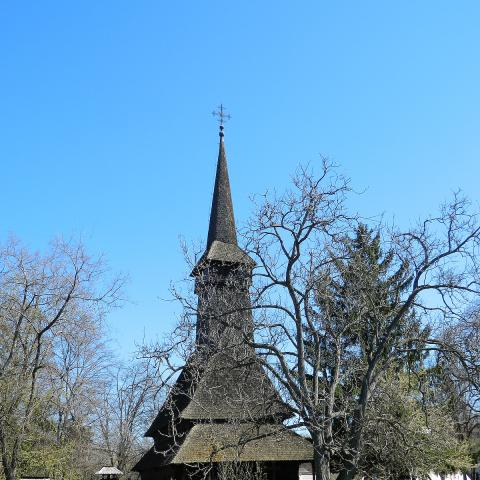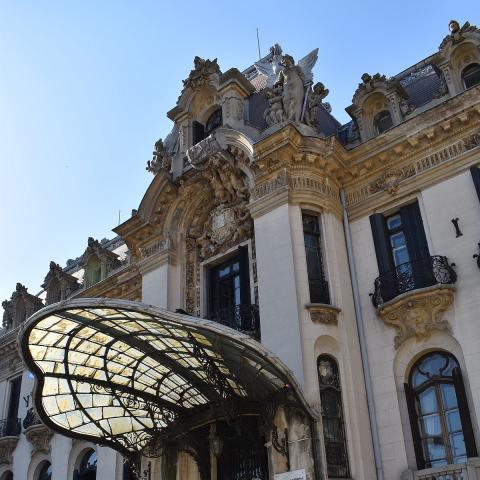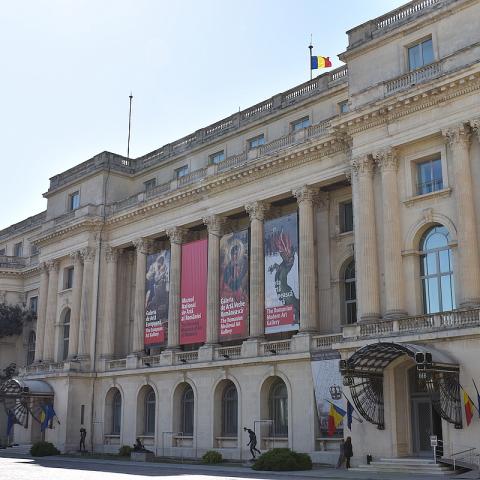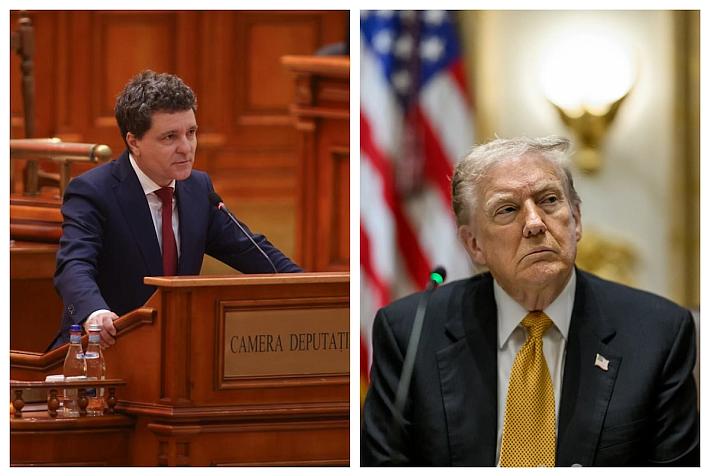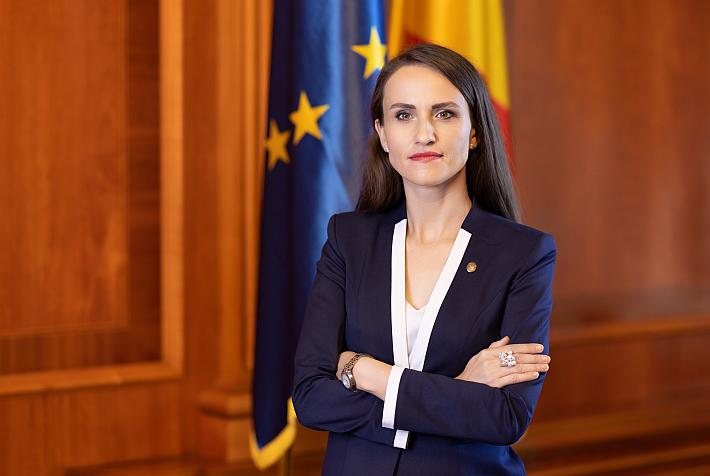"Destination: Bucharest" - Ten must-see works at Bucharest museums

The museums of the capital host numerous works that are worth admiring, studying and contemplating throughout a visit or more. History, arts, nature sciences or music – the options are not few and those who make time for a visit at the museum can discover the most interesting stories.
The steel crown of the kings of Romania
After Romania won its independence, following the Russian – Turkish war of 1877 – 1878, Carol I was crowned king. For his coronation ceremony, in 1881, the king preferred to have a crown made out not of precious metals but of steel, taken from an Ottoman cannon seized at Plevna, during the war. The government set up a commission to have the crown made. It included Grigore Tocilescu, Alexandru Odobescu, B.P. Hasdeu, while artist Theodor Aman drafted the design of the crown. The piece was also worn by King Ferdinand I, but also by King Mihai, at his second crowning, on September 6, 1940. A replica of the crown is kept at the Peleș Museum in Sinaia.
Where: The National Museum of History of Romania, 12 Calea Victoriei
The scepter of King Ferdinand I
Another important symbol of local history is the scepter of King Ferdinand I. Made out of gold, it was purchased through a public campaign. The item bears an inscription identifying Ferdinand I as the king of all Romanians. The inscription also mentions that the item was presented to the king as a reward for the way it led the country between 1916 and 1919. The king received the scepter on May 10, 1920, from a group of girls from the Radu-Vodă orphanage. On the scepter’s upper part, the silhouettes of four women in traditional costumes are depicted. They represent Romania (the old kingdom), Transylvania, Basarabia, and Bucovina, the provinces that were united in 1918.
Where: The National Museum of History of Romania, 12 Calea Victoriei
The Dacian bracelets of Sarmizegetusa
These extremely valuable pieces have a recent story seemingly written out of a mystery novel. The gold pieces were recovered from abroad after being looted from the site of Sarmizegetusa Regia, the capital of the Dacian kingdom prior to the wars with the Roman Empire. One bracelet surfaced at Christie's auction house in New York, in 1999, and others emerged in Frankfurt, Paris and London. The items, part of the Dacian treasury, were eventually recovered by the Romanian investigators, and the probe that lead to their finding became the subject of a documentary - The Hunt for Transylvanian Gold.
Where: The National Museum of History of Romania, 12 Calea Victoriei
The Dacian helmet of Coţofeneşti
Discovered in 1928 in the village of Coțofenești, in Prahova county, the helmet is made out of gold and weighs 770 grams. Dating back to the years 400 B.C., it was discovered by a pupil. It is believed to have belonged to a member of the Geto-Dacian aristocracy. The helmet is almost intact, missing only the top part. It is decorated with several parallel rows of studs, while a pair of prominent eyes are represented on the front plate. Its decoration combines element of local art with foreign ones, described as Persian-Iranian, but the way it was made points to a local origin.
Where: The National Museum of History of Romania, 12 Calea Victoriei
Revolutionary Romania by Constantin Daniel Rosenthal
One of the most easily recognizable local paintings, the work of artist Constantin Daniel Rosenthal is an allegorical representation of the moment of the 1848 revolution, when the social and national ideals of the 19th century made their presence felt in the Romanian provinces as well. It was painted in Paris, where the artist found himself together with other Romanian revolutionaries after the Wallachian uprising had been stifled. His model was Maria Rosetti, born Grant, the wife of C. A. Rosetti,one of the leaders of the revolution. She turned into a symbol of the Wallachian revolutionary movement because of the important part she played in helping release the local revolutionaries held prisoners by the Ottomans. She is depicted wearing a traditional local dress and carrying the Romanian flag in one hand.
Where: The National Museum of Art of Romania, 49-53 Calea Victoriei
The Danaïde by Constantin Brâncuşi
The works of the sculptor born in Romania often make headlines for the high sums they sell at various international auctions. The Danaïde is among the few Brâncușisculptures in Bucharest. The work, dating from 1908 – 1909, belongs to a period when the artist was concerned with the distillation of forms, and was eagerly trying to find his own way. Elements such as the broad forehead or the tilted gaze will later reoccur in other portraits, for instance those of Mademoiselle Pogany.
Where: The National Museum of Art of Romania, 49-53 Calea Victoriei
The Deinotherium gigantissimum skeleton
One of the stars of the Antipa Museum’s collections is the skeleton of the Deinotherium gigantissimum, “a giant, frightening animal,” according to its name’s translation. A relative of today’s elephant, the animal was an herbivore, over 4 meters tall, who disappeared more than 2 million years ago. The skeleton on display at Antipa was discovered in 1890 by geologist and paleontologist Gregoriu Ștefănescu, in today’s Vaslui county. At the time, it was the first, almost intact, Deinotherium skeleton. It took almost 15 years for it to be unearthed, and Belgian restaurateur Louis de Pauw came to the country to work on its setting up on a metal frame. The skeleton collapsed after the March 1977 earthquake and it took 34 weeks of work for it to be reassembled. To prevent similar situations, it was equipped with seismic isolation technology this summer.
Where: Grigore Antipa Museum of Nature History, 1 Sos. Kiseleff
Dragomireşti Church
Making up a valuable architectural patrimony, the wooden churches of Maramureş stand for one of the main attractions of the northern Romania region and eight of them have been included on UNESCO’s World Heritage list. Those who cannot travel there can see such a church at the Village Museum in Bucharest. Built in 1722, on the grounds of another one, burnt down by the Tatars in 1717, the church was brought to the museum in 1936. It is made out of spruce beams, on a rectangular layout, elongated towards the east, with the entire construction reaching 35 meters in height. The interior was painted by craftsmen who created scenes reflecting popular beliefs about the afterlife.
Where: Dimitrie GustiNational Village Museum, 28-30 Şos. Kiseleff
Castranova Hut
This ancient type of dwelling, identified since the Neolithic across Europe, could be found in the southern part of the country up until the first decades of the 20thcentury. The Village Museum hosts one from the village of Castranova, located between Craiova and Caracal. It was built around the middle of the 19th century, and transferred to the museum in 1949. It has four rooms: the sloped entrance (Romanian gârlici), the fire room, where the hearth was found, the living room, and the cellar (Romanian celarul), where food was stored. Various items, furniture pieces and traditional textiles can be seen inside.
Where: Dimitrie Gusti National Village Museum, 28-30 Şos. Kiseleff
George Enescu’s first violin
Throughout his career, musician George Enescu played ten violins, crafted by local or foreign luthiers. His first violin is kept at the George Enescu Museum, hosted in the Cantacuzino Palace, one of the most beautiful buildings in Bucharest. The violin was purchased by his father, Costache Enescu, in 1888, carrying the label of luthiers Gebrüder Platt.It is the violin used by young Enescu to play under the guidance of professor Eduard Caudella inIaşiand during his first years of study in Vienna. At the same museum, visitors can discover a wealth of memorabilia on the musician’s life and work.
Where: George Enescu National Museum, 141 Calea Victoriei
To keep in mind:
Most museums are closed one day per week, often on Mondays. At the same time, several museums offer free entrance once a month. Check the website of the museum you wish to visit to learn more about the program. Many museums do not accept card payment; it is important to have cash to pay for the ticket or other purchases.
This text is part of a project under the program of promoting the touristic heritage "Destination: Bucharest", carried out by the Bucharest City Hall through the Public Monuments and Touristic Heritage Administration (AMPT).
editor@romania-insider.com
(photos by Romania-Insider.com for AMPT)









